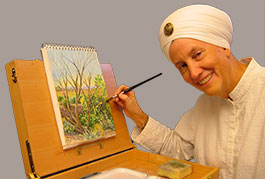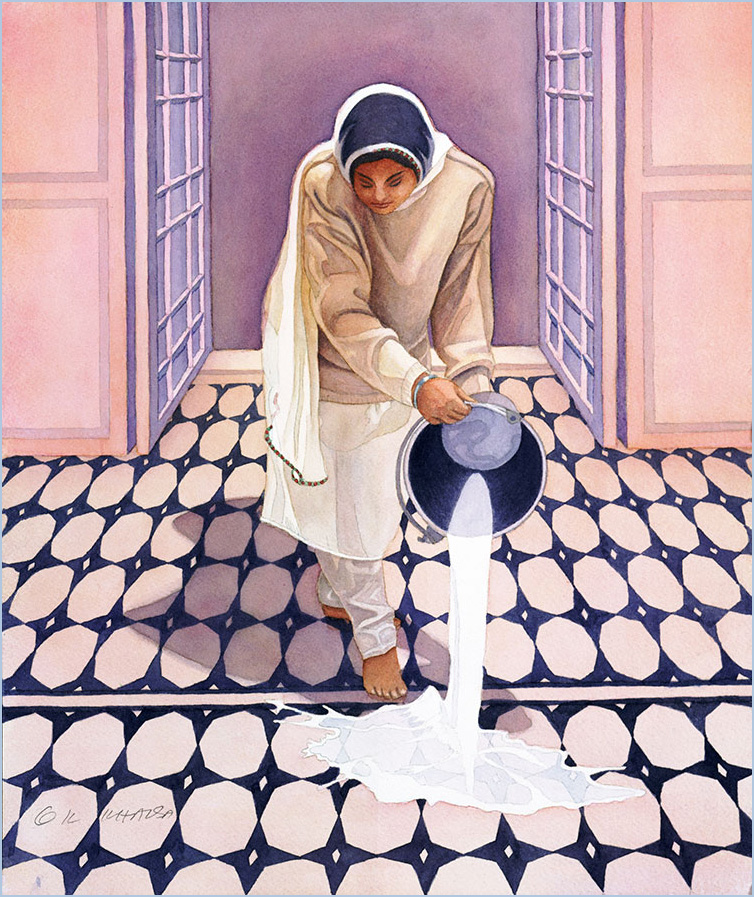Gurukirn Kaur Khalsa
Gurukirn Kaur Khalsa was born in 1951 as Joan Paulus in an educated Episcopalian family in Redlands, California. She began studying art and writing at an early age; by the time she was in the 6th grade, she knew she wanted to be an artist.
For high school, she went to the Ethel Walker School, an all-girls school, in Simsbury, Connecticut. It was an extremely creative environment for art, music, dance, theater and creative writing and formed the foundation for her later study and practice of art and writing.
Inner love ignited
She started college at Pomona College in Claremont, California in 1969. As this was during the height of the counterculture revolution, without even knowing it, she began to answer the call of her soul to be Sikh. She stopped cutting her hair, became a vegetarian, and studied eastern religions. In one text it stated that Kundalini Yoga was dangerous. When she saw a notice advertising a class on the bulletin board, she knew that that was the yoga for her! Through Kundalini Yoga classes, she learned how to meditate and started covering her head. She also met Yogi Bhajan, who wove stories about the Gurus and passages from Gurbani together with the yoga. In her sophomore year, she moved into the ashram and started doing a daily sadhana. Gurukirn Kaur loved living with a spiritual community and began learning more about Sikhism and the lives of the Gurus. In 1972 she took Sikh vows and later became a Sikh Minister.
She transferred to the University of California, Santa Barbara in the fall and helped start another ashram there. She graduated with a BA in studio art in 1974. In the same year she began wearing a turban, took Amrit and legally changed her name to Gurukirn Kaur. The following year she received a Teacher’s Credential from UCSB.
In the fall, she moved to Phoenix to work at the Khalsa School. It was at this point that the various directions of her life – Sikhism, teaching children, art, writing – began to merge. She married Jodha Singh in 1976. He had learned the Gurmukhi alphabet and recited Japji Sahib from the Gutka. So he became her Gurmukhi coach, teaching her the letters and pronunciation. Soon she was able to recite Japji Sahib from the Nitnem in morning sadhana which, to this day, is one of her greatest joys. They worked together running the Golden Temple Restaurant in Tempe. She painted while hostessing, getting up to seat the customers. She completed a large acrylic painting of the Golden Temple while there, which now resides at Hacienda de Guru Ram Das in New Mexico.
Sikhi, art and family
Her daughter, Guru Dev Kaur, was born two years later. When she was about two, Gurukirn Kaur began teaching a weekly Dharmic education class for the children. She developed a unique flannel story technique to share the stories of the Gurus, accompanied by coloring pages. These were later compiled into a coloring book, The Sikh Tradition, which can be downloaded from www.sikhnet.com. The class also included songs and Gurdwara protocol and seva.
During these years, she attended Khalsa Women’s Training Camp in New Mexico and learned many stories of Sikh women, such as Mai Bhago and Mata Sahib Kaur. As she continued her art practice, she felt inspired to present Sikh women in strong, archetypal images and poses. She also did commissioned portraits of Sikh children and adults, as well as the Sikh Gurus. Also, she taught art and Sikh history classes at Khalsa Youth Camp in the summer.
She became a juried member of the Arizona Artists Guild in the early 80s and began showing around the Phoenix area. Her paintings were always of Sikh subjects and stimulated curiosity about Sikhism from her fellow guild members and viewers. More recently, she became a juried member of the Arizona Watercolor Association in 2008.
In 1983, her son, Guru Dharam Singh was born and in 1988, Har Rai Singh. Guru Dev Kaur began attending Guru Nanak’s Fifth Centenary School in Mussoorie when she was eight. On Gurukirn Kaur's first trip to India, she felt as if she were coming home. Since then, she has learned that this is one of the most common phrases used by people who have come into Sikhism this way. Perhaps she and others like her are old Sikh souls who have come back another time around, only this time in the West. Her children went to school in India over a twenty-year period of time, first in Mussoorie, then in Dehra Dun, and finally in Amritsar. Through their their visits to them, she and her husband have been able to visit Amritsar, Kesgarh Sahib, Kiratpur, Goindval etc. The history of these places seems very real to Gurukirn Kaur, as if it happened only yesterday. The memories are still warm and she tries to capture this feeling in her art and writing.
India and greater responsibilities
On a visit to Kiratpur in 1994, she went to the Baba Gurditta Gurdwara. Outside there was a bazaar with a stall that sold engraved metal paintings. Of over fifty of them, not a single one was of a woman. She felt then that Sikh woman had no face. About this time, she became aware of the exclusion of women from ishnaan seva inside Harimandir Sahib. She wrote a poem, Pure Longing, and painted a picture of a woman washing the floors of Harimandir Sahib. This painting was presented to the acting Jathedar of the Akal Takht, Prof. Manjit Singh. In 1996, he arranged for women to clean the floors in the early morning seva. They were met outside by a screaming mob of men, shouting and waving their fists and pushing them back from the Mandir Gate. They were able to go inside to wash the floors, but the issue is still unresolved to this day. In all, she has painted five versions of the floor washing painting.
In 1996 she was appointed President of Sikh Dharma of Phoenix and served in that capacity until 2004. Phoenix has a large, multi-cultural sangat at Gurdwara Sahib Guru Nanak Dwara, and is something of a testing ground for the incorporation of Gurus’ teachings beyond the culture of Punjab. It has been a very challenging journey. Many Sikhs who came to the faith as a calling left their own cultures far behind and estranged friends and relatives. Yet they were not always welcomed by Sikhs of Indian descent either. Sometimes they were labeled as a gora Sikhs or white Sikhs. This was painful because of all that they had sacrificed to become Sikhs and how strong the feeling was inside that this is what they are. Gurukirn Kaur hopes that in time the assimilation of people of other backgrounds will become a welcomed process in Sikhism for, indeed, the Gurus’ teachings are for everyone. We only have to imagine Guru Nanak in China to think that this is what is meant to be. To prepare for this eventuality, the sangat in Phoenix is currently building a magnificent new Gurdwara.
Khalsa 1999 and beyond
Gurukirn Kaur was able to attend the Tercentenary celebrations of the birth of the Khalsa in Anandpur Sahib in 1999. The presence of Guru Gobind Singh was alive everywhere. She published her book of poetry and artwork, Pure Longing Fulfilled, to coincide with that event. A year later, she published Living with the Guru, a children’s storybook. Two years later, the Centennial Foundation in Toronto presented her with an award for artistic contributions to the Sikh community.
Since 9/11, she has been a board member of the Arizona Interfaith Movement, giving talks on Sikhism in churches and schools, on TV and radio. She was part of a delegation which went to Spain in 2004 to the World Parliament of Religions. Finally, she served as the Chairwoman of the International Khalsa Council from 2003-2005.
Her greatest passion is to create works of art and literature for our children so that they will feel proud that they are Sikhs and will cherish the gifts that the Sikh Gurus and the Siri Singh Sahib have given to all of us. Her work can be seen at www.gurukirn.com
- Photos copyright by Gurukirn Kaur Khalsa


